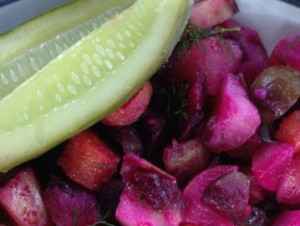As we move into summer I have been thinking about sunflower seeds and all the encounters I have had with them in Russia and Ukraine over the years, starting with toasting mounds of seeds in an old skillet suspended over a campfire in Siberia and watching everyone’s hands and lips turn black from splitting the shells and extracting the warm, flavorful meat. Later, doing oral history research on WWII, sunflower pressings, or zhmyx reappeared, remembered in representations of deprivation and near starvation on the home front. When I began doing research in the Zakarpattia region of Ukraine I heard of people who had made their family’s fortune growing and processing sunflower seeds and oil. While of course the oil is the real money-maker I somehow imagined this sunflower mogul mobilizing hundreds of sellers to sit on street corners and in markets with burlap sacks of seeds, selling them by the cupful in paper cones to passersby. Sunflower seeds remain a popular snack food, now sold in impersonal plastic packets as well.
When I first began to do fieldwork in Russian in 1991, sunflower oil was one of the few cooking oils available for purchase. The oil was not really refined, amber in color with the distinctive toasty tang of oil pressed from unshelled seeds and decanted directly into old soda bottles and other containers. The oil added a certain flavor to salads and other foods – a flavor that has all but disappeared with the influx of commercial oils onto the market starting after the fall of the Soviet Union. The disappearance of this flavor represents a line of cultural demarcation for me that stands as an icon of a broad range of cultural reassessments. What was once a sought-after addition to foods, seen as augmenting their flavor, rapidly transformed into an “aftertaste” to be eliminated through the purchase of more expensive, more highly refined, and at least early on in the post-Soviet period, imported oils. And yet…When I hosted some visitors from Bashkortostan a few years ago, they lit up when they tasted salad to which I added a few drops of sesame oil to evoke that same sensation – a toasty/bitter/intense flavor. The taste of sunflower oil is one of that catalogue of things, so firmly embedded in the sensations of the Soviet Union, tastes, textures, smells, that I guess will fade away, though I wonder sometimes why people gave up on this flavor so quickly, and do they miss it?
Recipe: Baby Vegetable Vinegret
A standby of Russian and Ukrainian tables is “vinegret” a salad composed of boiled and diced potatoes, beets and carrots, with pickles, onion, dill and often canned peas added to the mix, dressed with  vinegar and (sunflower) oil. While this salad is prepared year-round, I recently made an early-summer version using new potatoes and baby beets and carrots. Unlike a traditional vinegret, I did not peel the vegetables, and I sliced them into chunks, rather than a 3/8″ dice. Freshly made pickles and fresh sugar snap peas complete this summer version of the traditional salad.
vinegar and (sunflower) oil. While this salad is prepared year-round, I recently made an early-summer version using new potatoes and baby beets and carrots. Unlike a traditional vinegret, I did not peel the vegetables, and I sliced them into chunks, rather than a 3/8″ dice. Freshly made pickles and fresh sugar snap peas complete this summer version of the traditional salad.
Ingredients:
1.5 lbs new potatoes
1 lb baby or young beets
1/2 lb baby or mature carrots
5 pickles, preferably half-sour, quartered and cut into 1/4 inch slices
10 sugar snap or snow peas, sliced crosswise into thirds
1/2 cup chopped white onion (if you don’t like raw onion, try substituting green onion)
3 tbsp finely chopped fresh dill
1/4 cup white vinegar
3 tbsp. oil (add a couple of drops of sesame oil if you like)
salt to taste
Cut off the beet stems, cover beetroots with water and boil until tender (a knife slides through easily). At the same time, in a separate pot boil the whole new potatoes with the baby carrots (break larger carrots in half if they won’t fit in the pot). Remove the baby carrots after about 10 minutes, when they should be tender, and continue boiling the new potatoes until a knife slides through the largest one easily. Drain all of the vegetables and cool.
Quarter the potatoes. Cut off the tips of the beets, and if the skins seems tough, slide off the beet skins, then quarter. If using mature carrots with thicker skins, remove the carrot peel from the cooked carrots. Slice carrots into rounds. Place the vegetables in a large bowl with the sliced pickles, onion, dill and peas. Add about 1/2 tsp. salt and toss quickly to mix. Whisk together oil and vinegar. Pour over the vegetables and mix gently until combined. Taste and adjust oil, vinegar and salt to taste (the amount of vinegar needed to balance the sweetness of the vegetables varies). Let stand at room temperature for 1/2 hour, then refrigerate until you are ready to serve.




Recent Comments